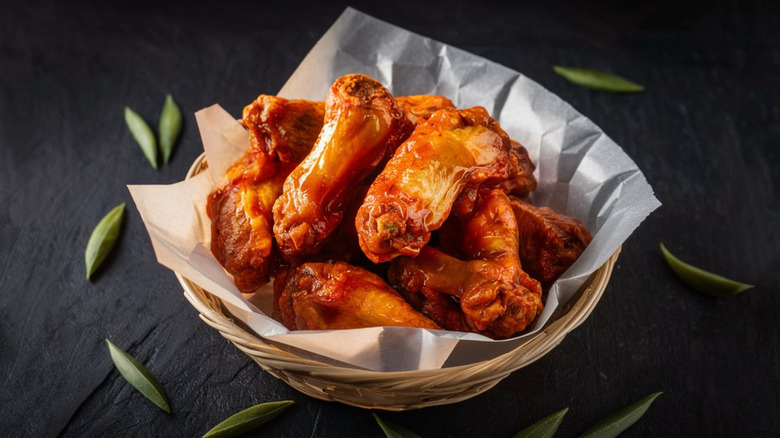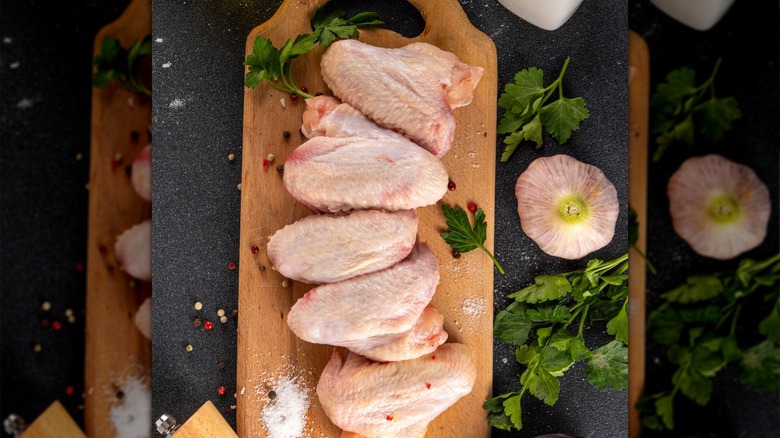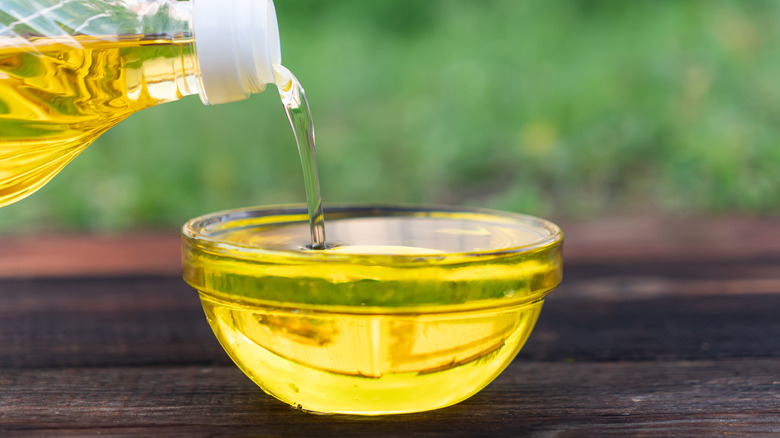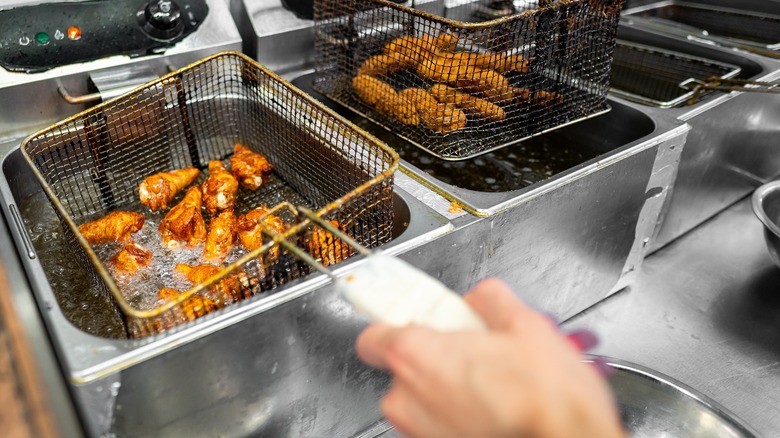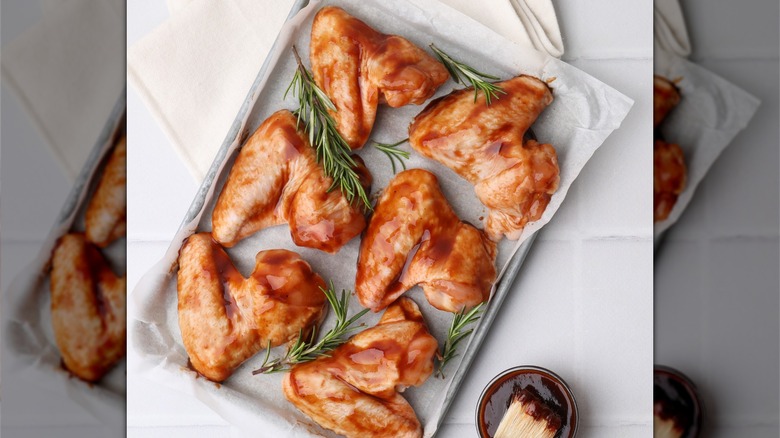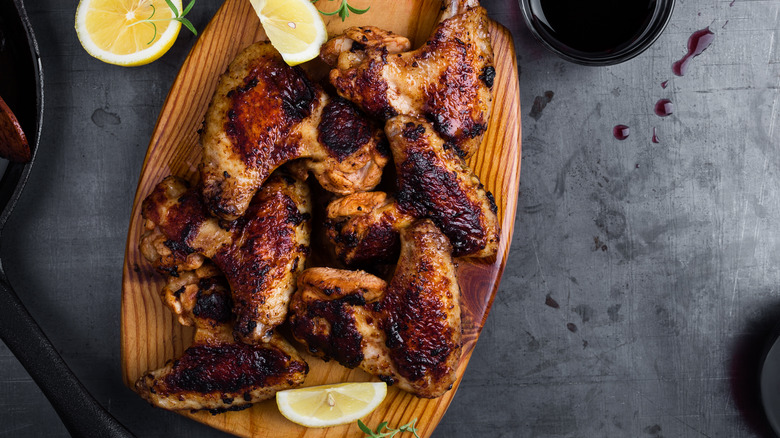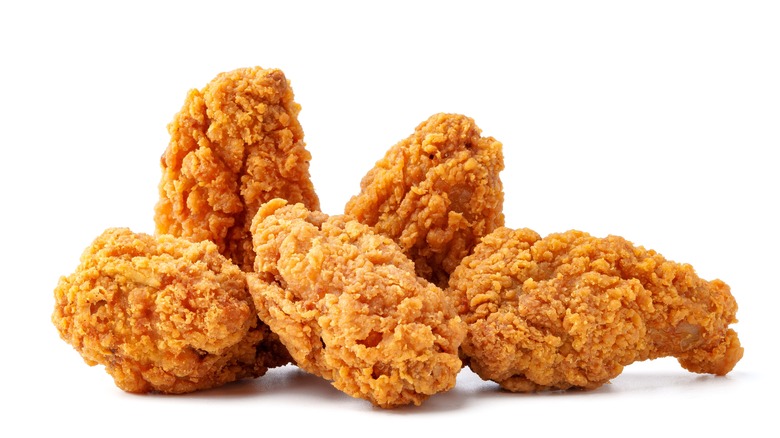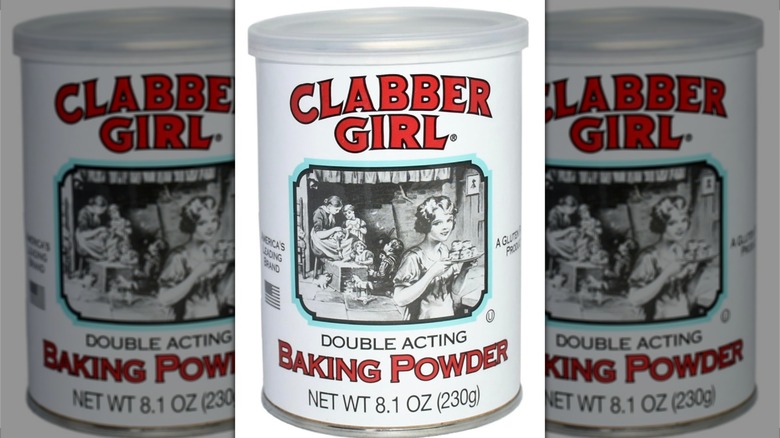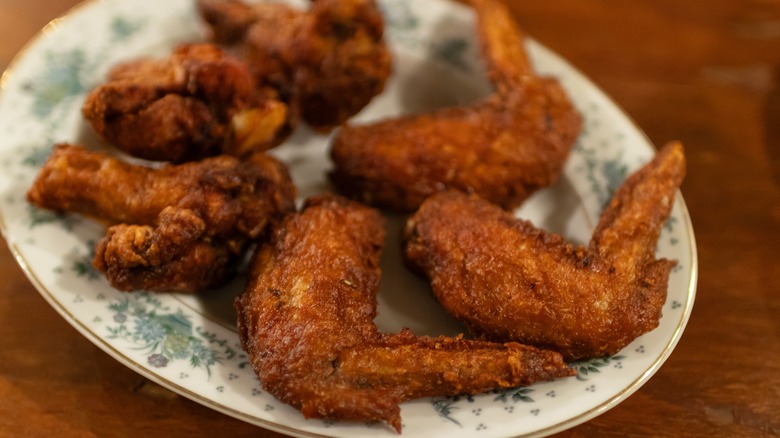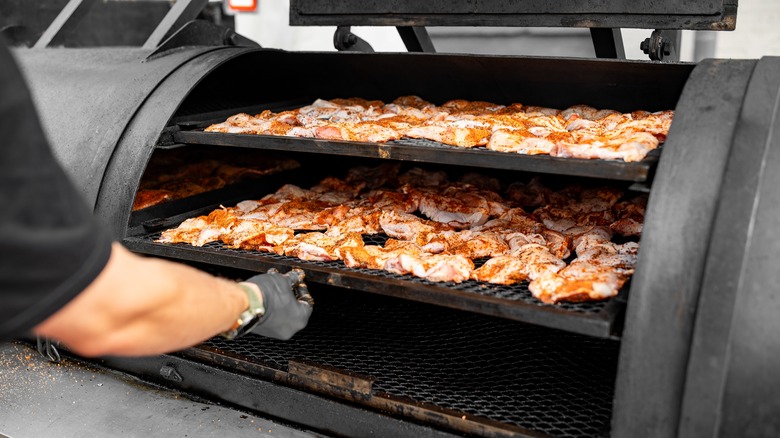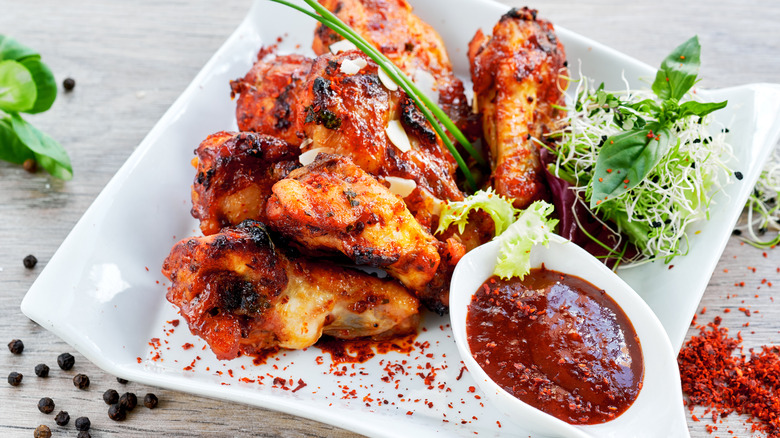Why Chicken Wings Always Taste Better At A Restaurant
We may receive a commission on purchases made from links.
In 2021, Americans consumed around 1.4 billion chicken wings and drumsticks from 700 million birds while watching the Super Bowl, as reported by Vox. There's little doubt that chicken wings have become a staple of American cuisine, with the finger food favored for their crispy skin and tender, juicy meat. This irresistible combination is elevated by the poultry's versatility, as chicken wings can be prepared in a variety of styles and paired with a wide range of different seasonings and sauces.
Whether breaded, fried, or smoked, chicken wings are only as good as the methods used to prepare them. Many home chefs struggle with imbuing chicken wings with the ideal blend of flavor and texture. One of the challenges is ensuring that the wings have a crispy exterior while keeping the meat juicy and tender. Others include getting the seasoning just right and coating the wings in sauce without making them soggy.
There are many good reasons why restaurant chicken wings come out perfect every time. And while you may not be able to replicate all of the techniques used by professionals in your own kitchen, taking a few cues from experts can be a game changer. To help you perfect the art of making chicken wings at home, we spoke to three culinary masterminds. These include research and development chef, Jaehong (Jae) Park, from the popular Korean chain Bonchon, the executive chef at Humble Baron, Jay Craddick, and the proprietor and operator of Wing Snob, Jack Mashini.
Restaurants use high quality chicken wings
Delicious chicken wings begin with the right ingredients. Even if you use the best cooking techniques, sub-par poultry is likely to sabotage the final dish. Chef Jae Park from Bonchon says that the quality of the ingredients the restaurant uses significantly impacts the flavor and texture of the wings. "Look for larger, more uniform wings as they cook evenly. Fresh wings also yield better results than frozen," he advises.
Just like with other meats, the process of freezing and thawing chicken can alter its texture and taste, especially if it's kept in the freezer for long periods of time. While freezing doesn't affect poultry's nutritional value, it can lead to the formation of ice crystals. Defrosting the chicken wings too fast can prevent them from reabsorbing the liquid from the melting ice crystals, leading to a tougher and drier final dish. This water loss is also responsible for drawing the flavor out of the chicken.
Wings consisting of drumsticks, drumettes, and wing tips should be divided to ensure more consistent cooking. To separate the pieces, place the poultry on a cutting board with the skin down and cut between the joints. This way, the drumettes won't dry out while the drumsticks cook. It's best to use the wing tips for chicken soup or stock since they don't have much meat and will burn if cooked with the other parts of the wings.
Chefs choose the right cooking oils
Cooking oils vary greatly, with some being suitable for frying and others faring better in salads and cold dishes. More specifically, oils are categorized as having either a high or low smoke point. Also sometimes referred to as the burning point, the smoke point of an oil is the temperature at which it starts to break down and create smoke. When this happens, the oil can impart the food with an unpleasant flavor or even start releasing harmful compounds.
According to chef Jae Park, the best oils to use for frying chicken wings are either canola or vegetable oils since they both have high smoke points of between 400 and 450 degrees Fahrenheit. Unlike some oils like peanut oil or coconut oil, they also feature a neutral flavor that's not going to affect the final dish. On the flip side, when frying chicken wings, it's best to steer clear of low smoke point oils like extra virgin olive oil, flaxseed oil, wheat germ oil, and walnut oil.
When frying chicken wings, it's crucial to preheat the oil. Throwing the poultry into lukewarm oil that hasn't reached the right temperature can lead to uneven cooking and greasy wings. On the flip side, preheating the oil not only ensures that the exterior of the wings will crisp up fast but that the juices will be sealed inside the poultry. Another important thing to remember is to pat dry the wings prior to cooking, as moisture can interfere with the crisping process.
Restaurants use specialized equipment
Although you can fry chicken wings at home using a deep frying pan, a quality Dutch oven, or even an air fryer, these won't usually match the quality of chicken wings fried in industrial deep fryers used at many restaurants. This is because commercial fryers provide high and uniform temperatures, which can be crucial for crisping chicken wings without overcooking them. In addition, industrial fryers are powerful enough to compensate for the heat lost when a large batch of cold chicken wings is added to the oil, ensuring that the fryer stays at the optimal temperature throughout the cooking process.
Chef Jay Craddick, the executive chef at the Humble Baron in Shelbyville, Tennessee — which isn't just home to the longest bar in the world but also makes outstanding chicken wings — says that the precise temperature control of commercial deep-fryers is critical. "[It] makes for even cooking, resulting in wings that are perfectly crispy on the outside and tender on the inside every time," says Craddick. The proprietor and operator of the casual fast food chain, Wing Snob, Jack Mashini agrees, adding, "The consistency in temperature helps to ensure even cooking, giving wings their signature crispy outside and juicy inside. Commercial fryers are designed to maintain the right oil temperature even [for] large batches, which is key to getting wings cooked just right."
Restaurants brine or marinate chicken wings prior to cooking
Marinating or brining chicken wings doesn't just infuse them with flavor, but it can also tenderize them. While leaving the chicken wings in a marinade for a few hours usually does the trick, chef Jay Craddick recommends marinating the poultry overnight. "[This] allows the flavors to penetrate deep into the meat, making for wings that are fully flavored all the way to the bone, not just on the surface," he explains. Chef Jae Park from Bonchon agrees, adding that marinating poultry is particularly important when making Korean-style wings, which are known for their bold flavor.
Brining offers an alternative to marinating and is a great way of enhancing the flavor and texture of chicken wings. The process of brining involves submerging the poultry in a solution of salt along with other ingredients like sugar, spices, and garlic. Since brine is a liquid, it can penetrate deep into the chicken, imbuing it with flavor. Additionally, brining also helps to denature the muscle fibers in the chicken, breaking them apart and making the meat more tender. For best results, use 1 cup of table salt per each gallon of liquid and heat the mixture until the salt completely dissolves. Let the concoction cool before adding the chicken wings and brining them for between two and 12 hours. Once the brining process is complete, it's important to pat the chicken wings dry with paper towels, as excess moisture can interfere with the browning process.
Chefs use proprietary seasoning
Many restaurants swear by their signature seasoning mixes, which have been perfected over time. These blends often include a combination of distinctive herbs and spices that make the dish stand out from its competitors, as highlighted by chef Jay Craddick who says: "Our proprietary sauces and seasonings are game changers. At Humble Baron, we craft a house-made seasoning blend that's unique to our wings. Once you've created a signature flavor, it's nearly impossible to find anything comparable elsewhere."
So what is the best time to toss chicken wings in seasoning? While this can be technically done before or after cooking, Jack Mashini from the Wing Snob says that it's best to season wings right after frying while they're still hot so the seasoning sticks to the wings. Chef Jae Park from Bonchon seconds this, saying, "If you're using dry rubs like Cajun or lemon pepper, apply them immediately after frying when the wings are still hot to allow the seasoning to stick." However, he also adds that seasoning poultry with a basic mix of salt, pepper, garlic powder, and paprika before frying can also enhance the flavor of the messy snack. Whether you opt to season the wings before or after cooking, it's best to place the seasoning and the poultry in a bag and shake them together. This method will ensure that the wings are evenly coated in the mix of herbs and spices, ensuring consistent flavor and texture.
Restaurants use special breading techniques
There's something special about breaded chicken wings. Unlike standard fried wings, which rely solely on the seasoning or sauce for flavor, breaded wings add an extra crunch that elevates the overall dining experience. Breading also locks in moisture during the frying process, leaving the chicken wings tender and juicy on the inside. While there are many different breading recipes, Jack Mashini from the Wing Snob uses a mixture of flour, cornstarch, and spices like salt, pepper, garlic powder, and paprika. Meanwhile, chef Jay Craddick says that the wings at the Humble Baron are coated in seasoning, egg, hot sauce, and some mustard. It's clear that the recipes offer two different flavor experiences. While Mashini's mix of ingredients delivers a lighter and perhaps more classic take on chicken wings, Craddick's use of hot sauce and mustard in his breading introduces an element of tangy heat to the poultry dish.
After the chicken wings are coated in the breading, Craddick says that he dusts off any excess crust and places them on a sheet tray for at least five minutes to allow the breading to adhere to the chicken. Many restaurants also bread their chicken wings twice prior to frying, as explained by Mashini: "Double-dipping into the breading and refrigerating the wings for a short period before frying can also improve the crunch."
Chefs coat chicken wings in baking powder and cornstarch
Coating chicken wings in cornstarch helps absorb moisture, allowing it to crisp up during cooking. Meanwhile, tossing the poultry pieces in baking powder decreases the pH of the chicken skin, resulting in more even browning. It's important not to confuse baking powder with baking soda. While both are leavening agents, baking soda is 100% sodium bicarbonate while baking powder is composed of sodium bicarbonate, as well as an acid, like cream of tartar or cornstarch. To cut a long story short, coating the poultry in baking soda instead of baking powder is likely to leave the chicken wings with an unappealing flavor that's unlikely to go down well with diners.
Jack Mashini from Wing Snob says that covering chicken wings in a mix of baking powder and cornstarch is especially useful when baking. "[This method] can help achieve an extra crispy texture by helping to dry out the skin during cooking," he says. Chef Jay Craddick echoes this sentiment, saying, "Baking powder is key, because it acts like a salt. It helps draw moisture to the surface, where it can evaporate. Since they have similar reactions, we typically combine baking powder and table salt to amplify this effect, resulting in extra-crispiness."
Many restaurants fry chicken wings twice to make them extra crispy
Many chefs double fry their chicken wings to achieve the perfect balance of an extra crispy outer layer while keeping the meat juicy and tender on the inside. Chef Jae Park from Bonchon explains: "The first fry is to cook the wings through. The second fry is to crisp up the skin or batter. To replicate this at home, do the first frying and hold the wing in the air for one to two minutes, and then do the second frying. This process helps render out excess fat, making the skin crunchier." In addition, the resting period between the two frying sessions also allows more time for the water to evaporate off the skin of the wings, leaving a crispier and more desirable final result.
Jack Mashini from Wing Snob goes a step further, recommending that the wings should first be fried at a lower temperature of around 325 degrees Fahrenheit and later returned to the deep fryer for a second round at a higher 375 degrees Fahrenheit. In addition, if you're double frying chicken wings at home, you can fry them partially ahead of time and freeze them for when you're ready to finish cooking. While most restaurants don't do this, it can be a nice shortcut for home cooks who are short on time.
Restaurants smoke and flash-fry chicken wings
While many restaurants deep fry their chicken wings to create a crispy outer layer while keeping the inside juicy, this is by no means the only way to prepare the flavorful finger food. Smoking chicken wings can imbue the poultry pieces with a delicious, charred flavor and tenderize the meat, making it melt-in-the-mouth succulent. In addition, slow cooking the chicken wings on low heat with wood chips like hickory, mesquite, or applewood, can infuse them with a deep, smoky aroma that's bound to satisfy barbecue enthusiasts.
Chef Jay Craddick from the Humble Baron is known for his innovative approach to Southern cuisine. This includes one of his signature dishes – Hickory-Smoked Chicken Wings. The dish is slow-smoked before being flash-fried and tossed in the restaurant's special dust and drizzled with honey. The flash-frying method, where meat is fried for short periods of time at a high temperature, creates a crunchy exterior without drying out the protein's interior.
To make flash-fried smoked chicken wings at home, season the wings and smoke them for around an hour and a half at 225 degrees Fahrenheit. Once the wings reach an internal temperature of 145 degrees Fahrenheit – you can use a quality meat thermometer to ensure accuracy — they are ready to be flash-fried. To do this, preheat the oil to 375 degrees Fahrenheit and deep fry the chicken wings until their internal temperature reaches 175 degrees Fahrenheit.
Restaurants coat chicken wings in sauce right before serving
After the chicken wings have been removed from the deep fryer, most restaurants use a rack to drain them from any excess oil. Once nice and dry, the wings can be tossed in a sauce for more depth of flavor. In addition, many restaurants offer a range of sauce choices to ensure that each diner can customize the wings to their personal taste. For instance, Wing Snob offers close to 20 different sauces, such as Buffalo lemon pepper, garlic Parm, honey BBQ, and Cajun. Meanwhile, chef Jae Park says that the signature sauces at Bonchon include soy garlic and spicy. "[They are] both crafted with a blend of bold flavors that embody the perfect balance of sweetness, savory notes, and heat," he adds.
According to Jack Mashini, the chicken wings at Wing Snob are coated in a sauce or glaze during the last few minutes of frying or grilling to help the flavors set. Mashini also adds that it's best to toss the wings in the sauce immediately after they come out of the fryer so they absorb the flavors of the condiment and maintain a crispy texture. To complete the delicious picture, some restaurants also serve their chicken wing dishes with one or more sauces on the side. This allows patrons to mix and match the sauces and experiment with different flavor profiles.
